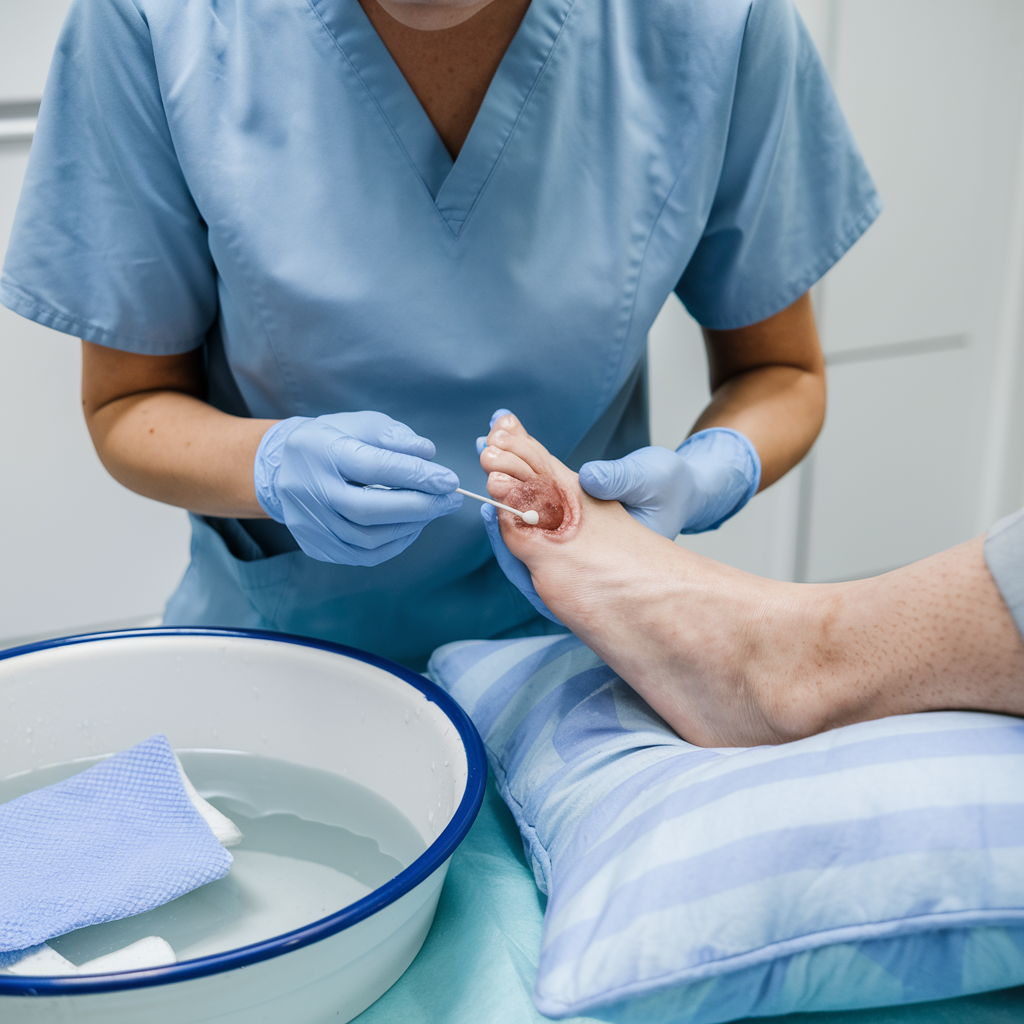A nursing care plan for diabetic foot ulcer is essential for managing this common complication in diabetes patients. Diabetic foot ulcers arise due to nerve damage (neuropathy), reduced blood flow, and delayed healing caused by high blood sugar levels. These ulcers can lead to severe complications, including infections and amputations, if not treated promptly.
Thank you for reading this post, don't forget to subscribe!
The primary objective of a nursing care plan for diabetic foot ulcer is to facilitate healing, control infection, and educate the patient on preventative measures. Nurses assess the condition, diagnose potential risks, implement interventions, and evaluate progress to achieve the desired health outcomes.
In this article, we provide a fictional example of a nursing care plan for a diabetic foot ulcer. Please note that the patient information provided is not real and is only for educational purposes.
Patient Information
- Name: John Doe
- Age: 65
- Gender: Male
- Medical History:
- Type 2 Diabetes for 20 years
- Hypertension
- History of peripheral neuropathy
- Ulcer Details:
- Location: Left heel
- Size: 3 cm x 2 cm
- Grade: Wagner Grade 2
- Symptoms:
- Pain, redness, swelling
- Delayed wound healing
- Moderate exudate with foul odor
- Medical Diagnosis: Diabetic Foot Ulcer
- Admission Date: January 10, 2025
- Care Plan Initiated: January 11, 2025
Note: The above details are fictional and provided for illustrative purposes only.


Nursing Care Plan for Diabetic Foot Ulcer
Nursing Assessment
| Subjective Data | Objective Data |
|---|---|
| Reports sharp pain in the affected area | Vital Signs: BP 145/95 mmHg, Temp 100°F, HR 88 bpm |
| Describes discomfort when walking | Hydration Status: Normal skin turgor |
| Concerned about infection and healing process | Wound Characteristics: Moderate exudate, redness, swelling |
| Reports tingling and numbness in feet | Laboratory Values: Elevated blood glucose (200 mg/dL) |
Nursing Diagnoses
- Impaired skin integrity related to diabetic foot ulcer.
- Risk of infection due to open wound and high blood glucose levels.
- Acute pain related to tissue inflammation and nerve damage.
- Knowledge deficit regarding diabetic foot care.
Nursing Interventions and Rationales
| Nursing Interventions | Rationales |
|---|---|
| Clean the ulcer daily using sterile saline. | Prevents infection and promotes healing by removing debris and bacteria. |
| Apply prescribed antibiotic ointment and cover with a sterile dressing. | Reduces bacterial load and protects the wound from contaminants. |
| Educate the patient about proper foot hygiene and footwear. | Empowers the patient to prevent further complications and ulcers. |
| Monitor blood glucose levels and administer insulin as prescribed. | Stabilizing blood sugar is critical for effective wound healing. |
| Encourage offloading of the affected area with specialized footwear or devices. | Reduces pressure on the ulcer, facilitating faster tissue recovery. |
Nursing Goals
- The wound will show visible signs of healing (reduced redness, decreased size) within two weeks.
- The patient will demonstrate proper diabetic foot care practices within one week.
- Blood glucose levels will stabilize within the target range of 80–130 mg/dL.
- No signs of infection will be present within the next evaluation period.

Evaluation and Expected Outcomes
- The ulcer’s size and exudate levels reduced by 30% after two weeks of consistent care.
- The patient reported improved understanding of diabetic foot care techniques.
- Blood glucose levels consistently stabilized within the target range.
- No signs of infection were observed during follow-up assessments.
FAQs
- What is the importance of a nursing care plan for diabetic foot ulcers?
It ensures systematic care to promote healing, prevent complications, and educate the patient on managing the condition. - How often should a diabetic foot ulcer be assessed?
A diabetic foot ulcer should be assessed daily or more frequently if complications arise. - Can diabetic foot ulcers heal completely?
Yes, with proper management, including controlled blood sugar and wound care, most ulcers can heal. - What increases the risk of diabetic foot ulcers?
Poor blood sugar control, smoking, peripheral neuropathy, and inadequate foot care significantly increase the risk. - What role does footwear play in diabetic foot care?
Proper footwear prevents pressure sores, protects from injuries, and supports healing in existing ulcers.
Recommended Resources
- American Diabetes Association – Foot Care
- Wound Care Society – Diabetic Foot Ulcers
- Mayo Clinic – Diabetic Foot Ulcer Management
This detailed nursing care plan for diabetic foot ulcer highlights the structured approach nurses use to manage and improve patient outcomes. Proper care, combined with education, plays a crucial role in preventing complications.



Comments are closed.